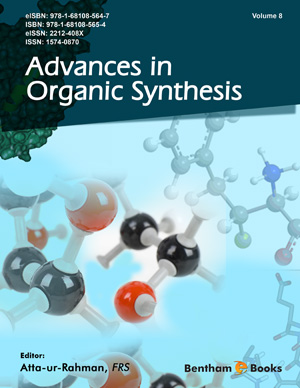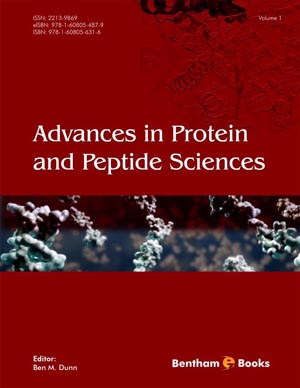Book Volume 8
Catalytic Tandem Reactions Triggered by the Introduction of a Carbonyl Function
Page: 1-31 (31)
Author: Pascal D. Giorgi and Sylvain Antoniotti
DOI: 10.2174/9781681085647118080003
PDF Price: $30
Abstract
Catalysis has played a prominent role in recent decades allowing chemists to develop novel and efficient reactions in almost every class of chemical transformation. With the tuning of the catalysts’ steric and electronic properties, sophisticated reactions have been discovered, sometimes featuring several individual steps and resulting in one-pot formation of complex chemical structures with high atom-economy. With the increasing recognition of the importance of green and sustainable chemistry, the concept of step-economy has gained traction and one-pot multistep reactions have been developed. Current research in this area now focuses on the use of multiple catalysts within the same reactor to convert simple and available substrates into complex and valuable products. In this chapter, we review a selection of examples of catalytic tandem reactions triggered by the introduction of a carbonyl function either formed by oxidation of alcohols, hydroformylation, isomerisation or carbonylation. In particular, we emphasize nanocatalysis, the use of metal nanoparticles as catalysts. The in situ formation of reactive carbonyl electrophiles opens a wide array of possible subsequent reactions as illustrated in the following pages.
Synthetic Applications of Bifunctional Knölker Type Iron Complexes as (De)hydrogenation Catalysts
Page: 32-80 (49)
Author: Raffaella Ferraccioli
DOI: 10.2174/9781681085647118080004
PDF Price: $30
Abstract
Knölker type iron complexes, used directly or generated in situ, are suitable catalysts for (de)hydrogenation reactions enabling the synthesis of carbonyl derivatives, amines and alcohols of industrial and academic interest. Enantioselective hydrogenation of prochiral C=X double bonds (X: O, N) was achieved with up to 94% e.e. using iron-complexes bearing chiral ligands or Knölker’ complex in combination with a chiral additive. Knölker type complexes were also competent catalysts for sequential reactions based on temporary dehydrogenative alcohol activation including dynamic kinetic resolution of racemic secondary alcohols (99% e.e.) and borrowing hydrogen methodology. The latter method was applied to synthesize N-alkyl substituted amines, α-alkylated ketones and oxygen- or nitrogen-heterocycles.
Superelectrophilic Activation of Alkynes, Alkenes, and Allenes
Page: 81-120 (40)
Author: Aleksander V. Vasilyev
DOI: 10.2174/9781681085647118080005
PDF Price: $30
Abstract
Recent advances in organic synthesis based on superelectrophilic activation of alkynes, alkenes, allenes, and their trifluoromethyl substituted derivatives under the action of Brønsted superacids (CF3SO3H, FSO3H, HF), strong Lewis acids (AlCl3, AlBr3), conjugate Brønsted-Lewis superacids (CF3SO3H–SbF5, FSO3H–SbF5, HF–SbF5, HBr–AlBr3, HCl–AlCl3) or superacidic H+-zeolites are considered. These reactions proceed through an intermediate formation of carbocationic and other cationic species and lead to the formation of various functionalized compounds, carbocycles, heterocycles under mild conditions and in high yields of target products. In many cases, cationic reaction intermediates are detected and thoroughly studied by means of NMR in superacids (CF3SO3H, FSO3H), that help to prove reaction mechanisms.
Chitosan and its Derivatives: Synthesis Strategy and Applications
Page: 121-174 (54)
Author: Tecia V. Carvalho, Raphaela V. Barreto, Alysson L. Angelim, Samantha Pinheiro Costa, Walderly M. Bezerra, Francisco E. A. Melo, Afrânio A. Craveiro, Gloria Maria Marinho da Silva Sampaio, Gilberto Dantas Saraiva, Vicente de Oliveira Sousa Neto, Vania M.M. Melo and Ronaldo Ferreira do Nascimento
DOI: 10.2174/9781681085647118080006
PDF Price: $30
Abstract
This chapter provides a recent description of chemical synthesis, encapsulation of chitosan microspheres and the incorporation of microorganisms involving technological advances to bioremediation of inorganic and organic environmental pollutants as well as their antimicrobial activity. In addition, the potential of chitosan and their derivatives in the bioremediation of water polluted by oil spills, heavy metals, dyes, phenols and pesticides is explored.
Synthesis of N-Containing Heterocycles via Hypervalent Iodine(III)-Mediated Intramolecular Oxidative Cyclization
Page: 175-223 (49)
Author: Jiyun Sun, Daisy Zhang-Negrerie, Yunfei Du and Kang Zhao
DOI: 10.2174/9781681085647118080007
PDF Price: $30
Abstract
Hypervalent iodine(III) reagents, including iodosobenzene diacetate, iodosobenzene bis(trifluoroacetate), iodosylbenzene, iodobenzene dichloride, hydroxy(tosyloxy) iodobenzene (Fig. 1), have been vastly used in various oxidative transformations in organic synthesis due to their low toxicity, commercial availability, ease of handling and environmental benignity. A striking feature of these hypervalent iodine(III)- mediated approaches is that these transformations may not need the participation of any transition metals. Thus, the development of transition-metal-free method mediated by hypervalent iodine reagent for oxidative coupling reactions is a topic of great interest as such transformations represent an attractive alternative to the traditional transitionmetal- catalyzed oxidative reaction. Most strikingly, the hypervalent iodine has been utilized for the synthesis of a variety of biological interesting N-containing heterocyclic compounds including indoles, oxazoles, oxindoles, azirines, diazepin-2-ones, carbazolones, quinolin-2-ones, 1,4-benzodiazepines, spirooxindoles, etc under mild reaction conditions (Fig. 2). In this chapter, we highlight all the representative methodologies that have applied the common hypervalent iodine(III) reagents as oxidant in synthesizing the biologically interesting N-containing heterocyclic compounds through intramolecular oxidative C-C, C-N, C-O, N-N bond forming reactions as well as cascade reactions in some cases. The presentation is organized according to the ring sizes and the ring patterns of the intermediate (spiro vs. fused) formed during the intramolecular oxidative cyclization step. However, the application of hypervalent iodine(III) reagents together with the transition metals for the synthesis of N-containing heterocyclic compounds will not be discussed in this chapter.
Advancements in Ionic Liquids for the Formation of Morita Baylis-Hillman Adducts
Page: 224-254 (31)
Author: Gitanjali Jindal, Navneet Kaur and Subodh Kumar
DOI: 10.2174/9781681085647118080008
PDF Price: $30
Abstract
The reactions involving the carbon-carbon bond formation are the most significant and fundamental reactions in synthetic organic chemistry. Amongst such various types of reactions, Morita Baylis-Hillman (MBH) reaction has become one of the most constructive and popular routes for the production of functionalized molecules with vast utility and prospective. This reaction involves coupling of the activated alkenes with a variety of aldehydes under catalytic influence of tertiary bicyclic amines, phosphines or ionic liquids. The present significance of this reaction is credited to the fact that it leads to one-pot atom-economical construction of carbon-carbon bonds providing multifunctional molecules. Recently, ionic liquids are most extensively used for the synthesis of adducts of this reaction. This review is presented by the purpose of summarizing the various advances in ionic liquids and their use in this reaction.
Introduction
Advances in Organic Synthesis is a book series devoted to the latest advances in synthetic approaches towards challenging structures. It presents comprehensive articles written by eminent authorities on different synthetic approaches to selected target molecules and new methods developed to achieve specific synthetic transformations. Contributions are written by eminent scientists and each volume is edited by an authority in the field. Advances in Organic Synthesis is essential for all organic chemists in academia and the industry who wish to keep abreast of rapid and important developments in the field. This volume presents the following reviews: o Catalytic Tandem Reactions Triggered by the Introduction of a Carbonyl Function o Synthetic Applications of Bifunctional Knölker Type Iron Complexes as (De)hydrogenation Catalysts o Superelectrophilic Activation of Alkynes, Alkenes, and Allenes o Chitosan and its Derivatives: Synthesis Strategy and Applications o Synthesis of N-Containing Heterocycles via Hypervalent Iodine(III)-Mediated Intramolecular Oxidative Cyclization o Advancements in Ionic Liquids for the Formation of Morita Baylis-Hillman Adducts






















